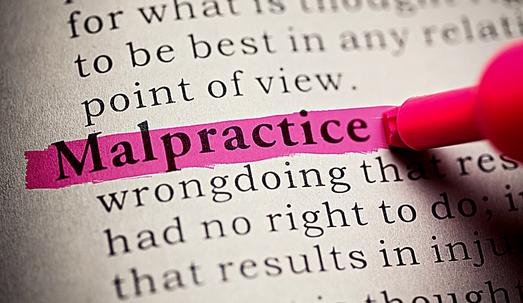The 4 elements of malpractice include a duty of care, breach of the duty of care, harm or injury due to the breach of care, and damages from the sustained injury. All four of these must be shown for the patient to prove he or she has a legitimate malpractice claim. If a breach of care occurs, but it does not lead to any harm to the patient, then it cannot be eligible for a medical malpractice claim.

An estimated 250,000 people each year die due to medical malpractice in the United States. This number does not account for all medical malpractice cases, but only the ones that have been reported. Doctors and medical facilities hesitate to report errors, especially if that error or neglect has lead to a fatality.
Table of Contents
4 Elements of Malpractice
If a patient believes medical malpractice has occurred, then it is best to start consulting legal representation. Documents a lawyer might require can include medical records, hospital records, labs, and even doctor and nurse notes. These can be used to prove several of the elements of malpractice, which might also be referred to as the four d’s.
These medical records can show which facilities or professionals were involved in specific parts of the treatment plan and their actions on the case. This timeline can help to pinpoint who all is responsible for the error or injury, so all liable parties can be listed in the lawsuit. Not identifying all possible defendants might mean that the injured patient will lose out on potential compensation for his or her claim. If the medical error lead to the death of a family member, then a medical malpractice lawyer can advise the family on how to sue the hospital for wrongful death. A wrongful death lawsuit allows family members to file on the decedent’s behalf and be awarded with the same damages that the injured party would have received if he or she had been able to file the case.
A lawyer experienced in medical malpractice can review the case and begin to gather evidence to prove the four elements of malpractice.
Duty of Care
The first element that must be proven is that the medical professional or facility owed a duty of care to the patient. This duty of care begins when a doctor agrees to see and treat a patient, entering into a professional relationship with the patient. This relationship means the treating physician agrees to provide care to the patient that other medical professionals would provide under similar conditions.
Using medical records, the patient should be able to prove that a duty of care was owed to him or her by the treating physician. If more than one doctor treated the patient, such as in an emergency room, then hospital records can show which medical professionals were involved in the care of the patient. Hospital records may also have additional information on technicians or lab specialists that are not included in medical records.
The professional relationship between doctor and patient can also be established if a physician is covering for another doctor and treating his or her patients, as well as if a doctor provides emergency services outside a medical facility. If an error is made during these types of situations, then the patient is still able to sue the doctor for medical malpractice.
Breach of Duty of Care
Once it has been proven that the medical professional or facility owed a duty of care, it must be shown that that duty of care was breached. To prove this, the standard of care by the medical industry should be explained. For example, if a patient comes into the emergency room with a broken leg, how would any doctor treat that broken bone under similar circumstances? This can also be one of the hardest elements to prove in a medical malpractice case.
Using a medical expert’s testimony is the best way for the standard of care to be established. The expert can explain to the court the medical terms and procedures involved in the medical malpractice case. This way, the jury can hear how other doctors would have treated the patient under similar or the same circumstances and compare that to what occurred in the course of treatment as described by witnesses.
Expert testimony may not be needed if the breach of care was obvious to the layperson. If the wrong body part has been removed or damaged through surgery, that is an egregious error that does not need to be explained.
Causation
The breach of care through either an error or neglect must be shown to have caused an injury or harm to the patient. If multiple physicians or professionals were involved in treating the patient, it can be difficult to show which one was the cause. It might also be the case that multiple parties were involved with the error, and all of those parties should be included in the lawsuit to help get the maximum possible compensation for the injured party.
The error is not always a direct injury to the patient, but also can include:
- A missed or delayed diagnosis, which may leave a patient suffering symptoms and pain for longer than necessary.
- Misdiagnosing the patient and proceeding with an ineffective treatment plan. This can also cause the patient to have to seek additional medical treatment to get a correct diagnosis, which can cause more expenses for the patient.
- Prescribing the wrong type or dosage of prescription, which may lead to further problems for the patient that could have been avoided.
- Leaving surgical instruments in the patient, which might lead to infection and further complications.
The breach of duty of care, through either an error or neglect, must have caused the patient pain, injury, or lead to the patient’s death for a medical malpractice claim to be valid. It must be clear that the error or neglect was the cause of additional damage or suffering for the patient in his or her care.
Damages
Damages are the financial compensation that can be awarded to the patient through a settlement or jury awarded amount. There are two types of damages that may be eligible in a medical malpractice case in Illinois. Economic damages are direct costs of the injury that can tracked and added up. This can include:
- All medical bills related to the error or injury, plus the costs of ambulance rides, prescriptions, ride fares to follow up appointments or rehabilitation, caregivers, and medical devices.
- Lost wages, as well as compensation for any missed opportunities and future wages if the ability to work as been compromised by the injury or error.
- Death and burial costs if the error or injury lead to a fatality.
Chicago medical malpractice lawyers can review the case and advise what can be included as economic damages. The patient should keep any documentation given by the medical facility or professional and receipts from any ride-share or taxi services that may have been used. A lawyer might also request copies of pay stubs and tax information to help establish an amount for lost wages. Having this sort of documentation available at the initial consultation can help a medical malpractice lawyer estimate recoverable damages and the strength of the case.
Non-economic damages focus on the loss in enjoyment of life due to the error or injury, which may affect the injured victim for the rest of his or her life. Pain and suffering, emotional distress, loss of consortium, and disfigurement are all examples of non-economic damages. Since these sorts of losses does not have a set monetary value, this amount is typically calculated using the total from the economic damages in the case.
If all four medical malpractice elements can be proven in a trial, it is still up to the jury to decide if damages should be awarded. A trial can be a lengthy process and does not always guarantee that damages will be received. This is why the help of an attorney is an essential asset.
A settlement can be reached at any point up to a trial, even if a lawsuit has been filed. It is best to have a lawyer go over any settlement agreements to make sure it is fair and covers all the eligible damages in the case. Some initial offers can be for amounts that may not cover all costs of the error. If the error lead to a permanent disability which will require future medical costs that should be taken into consideration.





